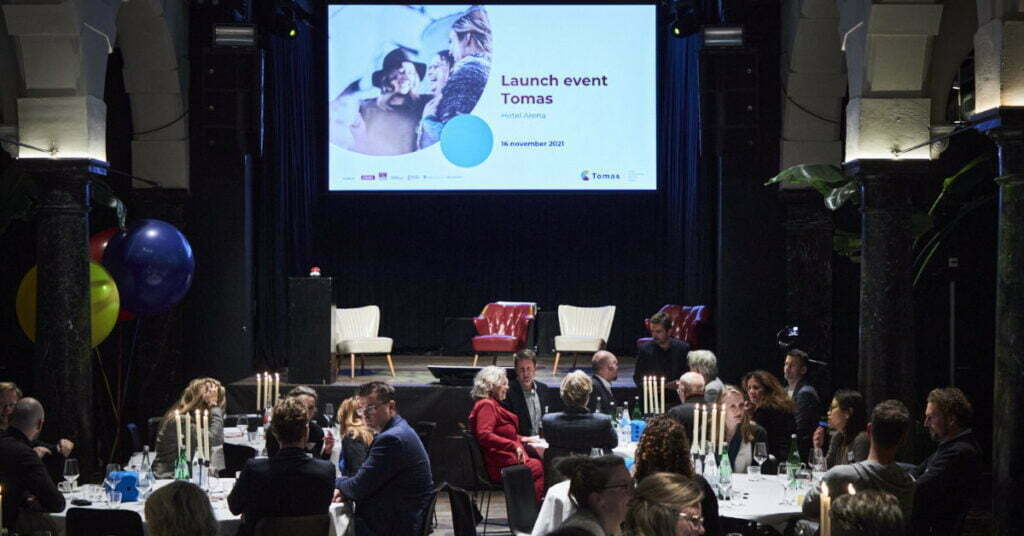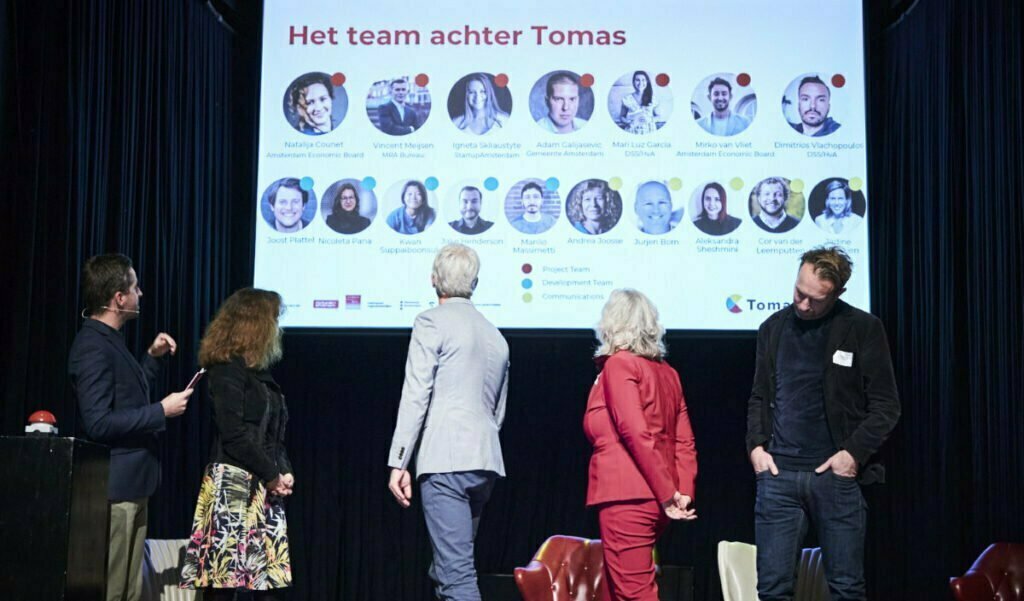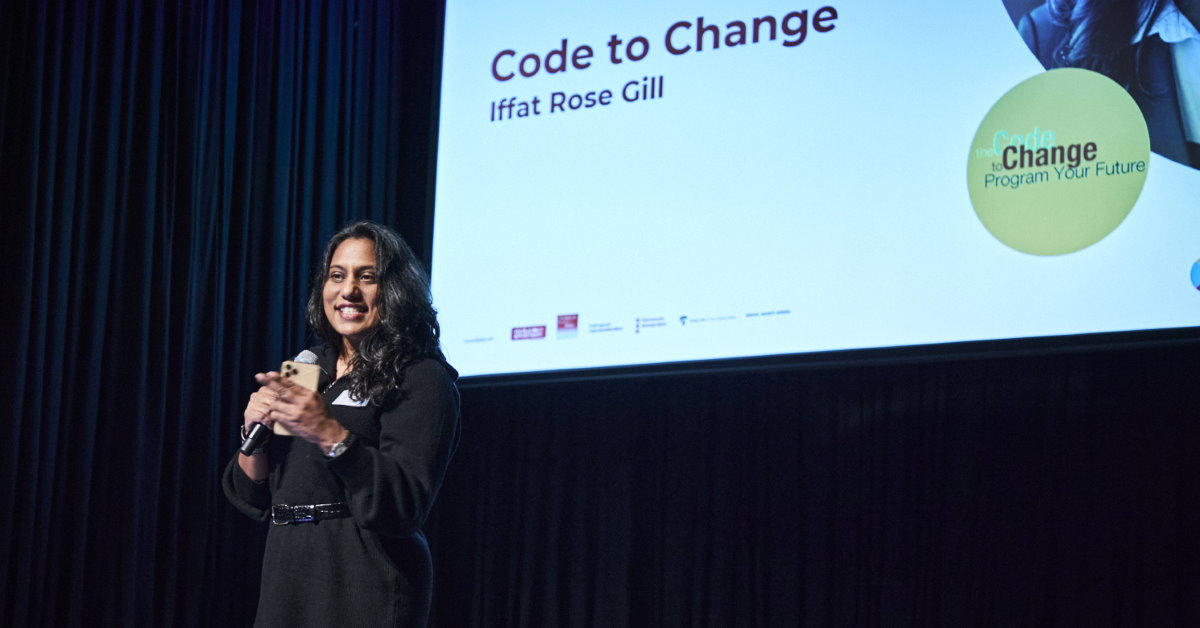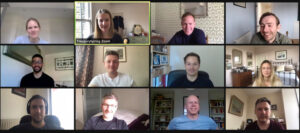Iffat Rose Gil of Code to Change presents during the TOMAS launch (Image: TOMAS/Brenda de Vries)
Ask any company in Amsterdam and they’ll tell you tech talent is hard to come by these days. On the other hand, there’s a plethora of academies, courses, talent initiatives and schools to provide that talent in and around the city. However, these two sides often struggle to find each other. That’s where TOMAS comes in. The newly launched initiative for the Amsterdam tech sector aims to close the talent gap.
TOMAS launched to match and select
TOMAS launched this week as an initiative of StartupAmsterdam, the Amsterdam Economic Board, Metropool Regio Amsterdam, HvA-Digital Society School and the municipality. The website serves as a platform where companies looking for talent can connect with talent initiatives and vice versa. Companies can browse through an interactive catalogue of over 120 talent initiatives in the area to find a matching partner. The catchy name is not randomly chosen, it’s short for Talent Ontwikkeling (development), Match and Select.
Get to know the amazing finalists here
Matching talent initiatives and companies looking for talent could solve a missing link in the Amsterdam technology sector, says Bas Beekman, Program Director of StartupAmsterdam. “I’m in touch with a lot of companies that are growing rapidly. When they want to attract young talent, they too often look at other countries. There’s a lot of talent in this area, but these companies don’t know many of the talent initiatives. They have no idea what the Universities are working on. TOMAS will help us make that connection.”
Tackling repetitive challenges
Igneta Skliaustyte is co-founder and community manager of TOMAS. She noticed governments, companies and talent initiatives were facing repetitive challenges: “As the amount of talent development initiatives grows very fast, it becomes harder for different private and public parties to benefit from it.

“The lack of overview hinders efficient decision making about investments, finding the right connections and making a good assessment on which potential initiatives to partner with. It leads at times to the inefficient use of resources, fragmented solutions, reinventing the wheel and blind spots in talent development. It also makes it hard for different parties to contribute, collaborate and learn from what is already out there.”
‘Upskilling becomes trendy’
The result is, as said, that Amsterdam businesses often rely on international talent, sees Skliaustyte. “This is due to high competition and the urgency to fill in the vacancies fast. Luckily we see a moderate transition towards a skill-based recruitment, instead of diploma based. Also the implementation of internal mentorship and upskilling programs are becoming ‘trendy’.”
TOMAS exists not only for companies to hire retrained talent, says Skliaustyte. “It’s also for them to work closely with the education system. That way they can make sure that their needs are incorporated in, for example, the curriculum development. The talent initiatives are open for such collaborations, we just need companies to be more proactive in creating the solution altogether, instead of waiting for one.”
Working in three ways
By creating an online B2B platform, accompanied by an offline community, Skliaustyte aims for a win-win-win situation: “It offers businesses resources to find reskilled and upskilled workforce and actual opportunities to contribute to the talent ecosystem. Initiatives will get recognition and partnerships based on their growth needs. Governments gain insights and overview for more structured, data-driven investments and informed advice.”
One of the initiatives that joined TOMAS is Code to Change. The Amsterdam-based, online training programme offers underrepresented groups a chance to gain digital skills needed for a career in tech. Iffat Rose Gill, founder and CEO of Code to Change, took the stage during the launch. Rose Gill acknowledges it’s sometimes hard to get recognition for the programme, which aims for gender equality and minimising the current skill gap.
Code to Change gains visibility
“Many companies are now focusing more on finding talent with diverse backgrounds. But we often notice they simply don’t know where to look. Women and minority groups often have limited access to social capital, which makes it difficult to get in contact with tech companies. We’re trying to bridge that gap.”
Getting across that gap was mostly a matter of manual labour, says Rose Gil. “We’d have to reach out to every individual company separately. With TOMAS, this is more automated and it makes it easier for companies to find us.”
So far, TOMAS seems to serve its purpose. Rose Gil has already gotten a few requests through the platform. “People from banks and the local government reached out after the launch. One of the departments of the municipality has a training programme for spouses of workers moving to The Netherlands. And we’re having good conversations with a very large bank.”
Strategic partner in solving the gap
Besides offering an online platform, Skliaustyte explains TOMAS also serves as a strategic partner in solving the talent gap: “We believe that talent development is a shared responsibility. Each party within the triple helix of government, companies and talent initiatives has an important role in tackling talent challenges. TOMAS MessageBoard matches the supply and demand at the point of need, such as financial, in-kind or strategic.”
Read also: Working in tech: Codaisseur, Codam and TechMeUp are closing the skill gap, but where is the money?
“We see the growing need in traineeships and job placements for reskilled and unskilled talents. Cooperation on improving curriculum. Exchanging knowledge via mentorship and volunteering programs. Making education accessible for underrepresented communities, providing career orientation or supporting new talent projects. All kinds of needs that could help the initiatives grow and make more impact.”

Now that the website is live, TOMAS will be co-organizing different strategic, matchmaking and network events to stimulate at least 30 new partnerships. Skliaustyte: “We are looking for enthusiastic organizations that would like to be involved and benefit from the local talent pools. One of the long term ambitions is a self-sustaining platform where initiatives and organizations connect without the intervention of government intermediaries. For TOMAS to reach its full potential, cooperation between businesses, talent initiatives and the government is essential.”
‘An ongoing conversation’
For StartupAmsterdam’s Beekman, it also means he can do his job a lot more efficiently. “We used to have a portfolio, an actual paper one, full of talent initiatives. And we carried that around to all the companies. Now we need to make sure these tech companies are going to use the new platform.”
“I hope TOMAS will develop the tech talent pipeline, and gets more local talent employed by startups in Amsterdam. And it will also offer initiatives the opportunity to better tailor their programmes to the needs of the companies. It’s going to be an ongoing conversation that will include all of those parties together.”
How partnering up with Salesforce helped him succeed!










